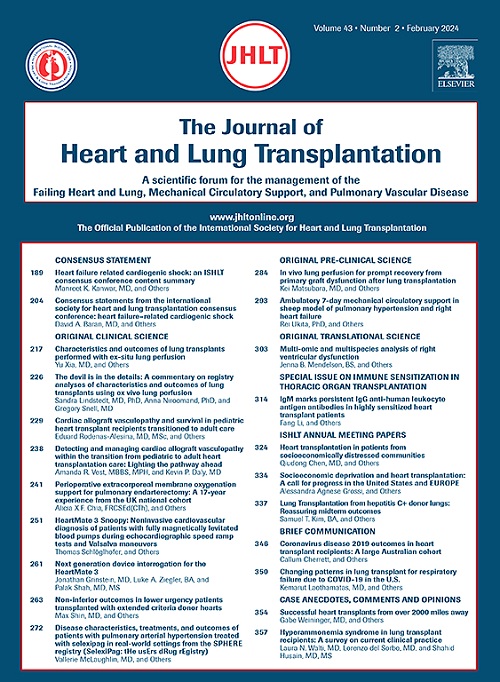A supply-based scoring approach to account for biological disadvantages in accessing lung transplant
IF 6.4
1区 医学
Q1 CARDIAC & CARDIOVASCULAR SYSTEMS
引用次数: 0
Abstract
Background
The lung Composite Allocation Score (CAS) accounts separately for biological disadvantages stemming from candidate blood type and height using consensus-derived heuristics, which do not reflect the true supply of compatible organs available to candidates with specific combinations of blood type and height. Here, we develop an alternative CAS biological disadvantages subscore using a novel measure of donor supply.
Methods
Using Scientific Registry of Transplant Recipients data from February 19, 2015 to September 1, 2021, we modeled daily distance-adjusted supply of compatible donors, as a function of candidate blood type, height, and diagnosis group, using Poisson rate regression and applied the model to create a 10-point supply-based subscore. Substituting this subscore in place of the 10 total points allocated to blood type and height in CAS created a “Supply-Adjusted CAS". We simulated population outcomes under Supply-Adjusted CAS, original CAS (March 2023) and “ABO Modified” CAS (September 2023).
Results
The supply-based subscore was more responsive to variations in candidate blood type, height, and diagnosis group than corresponding CAS or ABO-Modified CAS subscores. In simulation, waitlist mortality improved from 13.95 per 100 waitlist years under CAS and 14.12 under ABO-Modified CAS to 13.09 under Supply-Adjusted CAS. Transplant rates improved from 121.6 and 126.2 under CAS and ABO-Modified CAS, respectively, to 128.8 under Supply-Adjusted CAS. Height disparities improved substantially, while blood type disparities grew slightly relative to ABO-Modified CAS.
Conclusions
Supply-Adjusted CAS may improve lung transplant population outcomes overall while providing a more empirically based method to address equity.
以供应为基础的评分方法,考虑到肺移植手术中的生理劣势。
背景肺部综合分配评分(CAS)使用共识启发式方法分别考虑了候选者血型和身高造成的生物学劣势,但这并不能反映具有特定血型和身高组合的候选者可获得的相容器官的真实供应情况。方法利用移植受者科学登记处从 2015 年 2 月 19 日到 2021 年 9 月 1 日的数据,我们使用泊松率回归法建立了相容供体的每日距离调整供应模型,作为候选者血型、身高和诊断组的函数,并应用该模型创建了一个基于供应的 10 分子分数。在 CAS 中,血型和身高的总分为 10 分,用这一子分数代替血型和身高的总分,就得到了 "供应调整 CAS"。我们模拟了 "供应调整 CAS"、原始 CAS(2023 年 3 月)和 "ABO 修正 CAS"(2023 年 9 月)下的人群结果。结果与相应的 CAS 或 ABO 修正 CAS 子分数相比,基于供应的子分数对候选血型、身高和诊断组的变化反应更灵敏。在模拟中,候选者死亡率从 CAS 的每 100 个候选年 13.95 例和 ABO 改良 CAS 的每 100 个候选年 14.12 例提高到供应调整 CAS 的每 100 个候选年 13.09 例。移植率分别从 CAS 和 ABO 改良 CAS 的 121.6 和 126.2 提高到供应调整 CAS 的 128.8。结论供应调整 CAS 可以改善肺移植人群的整体结果,同时提供一种更基于经验的方法来解决公平问题。
本文章由计算机程序翻译,如有差异,请以英文原文为准。
求助全文
约1分钟内获得全文
求助全文
来源期刊
CiteScore
10.10
自引率
6.70%
发文量
1667
审稿时长
69 days
期刊介绍:
The Journal of Heart and Lung Transplantation, the official publication of the International Society for Heart and Lung Transplantation, brings readers essential scholarly and timely information in the field of cardio-pulmonary transplantation, mechanical and biological support of the failing heart, advanced lung disease (including pulmonary vascular disease) and cell replacement therapy. Importantly, the journal also serves as a medium of communication of pre-clinical sciences in all these rapidly expanding areas.

 求助内容:
求助内容: 应助结果提醒方式:
应助结果提醒方式:


